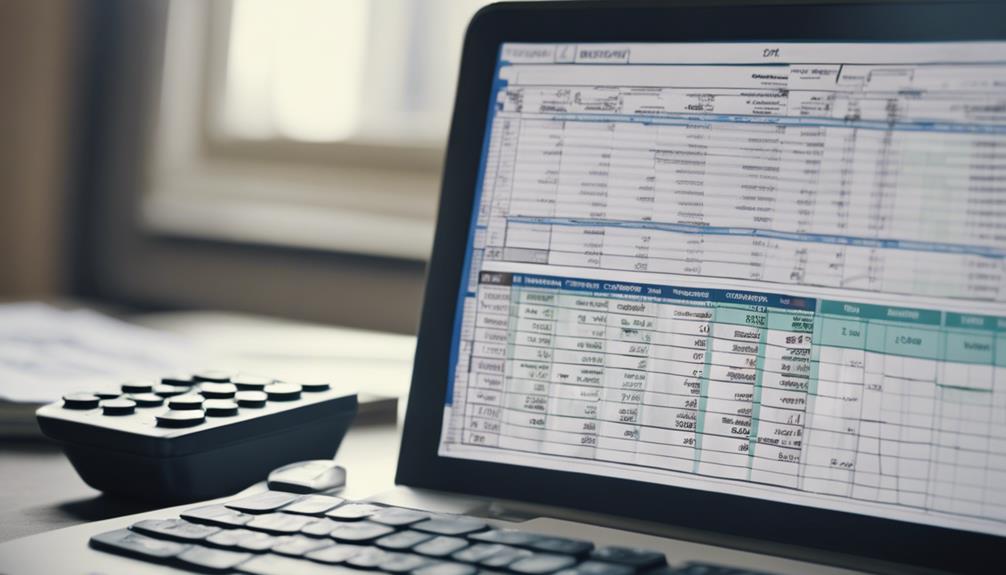When setting up your accounting system, have you considered the impact of automation on efficiency?
The integration of automation tools can streamline repetitive tasks, reduce errors, and free up valuable time for more strategic financial analysis and decision-making.
But that's just the tip of the iceberg when it comes to optimizing your accounting setup.
By exploring the seven best practices outlined, you can pave the way for a robust financial infrastructure that propels your business towards sustained growth and success.
Key Takeaways
- Choose compatible, user-friendly accounting software.
- Establish a comprehensive chart of accounts for efficient tracking.
- Ensure compliance, regular reconciliation, and tax adherence.
- Prioritize scalability, customization, and robust reporting features.
Importance of Proper Accounting System Setup
Understanding the significance of a well-structured accounting system setup is crucial for ensuring financial accuracy and compliance within a business. Proper accounting processes are the backbone of a company's financial health. By maintaining accurate records of financial transactions, including cash flow and financial statements, a business owner can effectively track income and expenses.
This organized approach not only streamlines tax filing but also aids in making informed decisions based on reliable data. Internal controls embedded within the accounting system help mitigate risks of errors and fraud, safeguarding the company's assets.
The setup of accounting systems goes beyond mere record-keeping; it provides a comprehensive view of the business's performance and profitability. Therefore, investing time and resources into establishing robust accounting systems is fundamental for any business seeking sustainable growth and financial stability.
Choosing the Right Accounting Software

When selecting accounting software, focus on software compatibility and a user-friendly interface to streamline your accounting processes efficiently.
Consider the features offered by popular options like QuickBooks, Xero, Sage Intacct, NetSuite, and Microsoft Dynamics to find the best fit for your business needs.
Evaluating these aspects will ensure a smooth transition and optimal utilization of your chosen accounting software.
Software Compatibility
To ensure a smooth integration of accounting software into your existing systems and workflows, prioritize selecting a solution that seamlessly aligns with your business needs and growth trajectory. When choosing the right accounting software, consider factors such as scalability, user-friendly interface, customization options, robust reporting, real-time insights, and the ability to streamline processes while reducing manual errors. Look for software that enhances overall efficiency in your accounting operations. Evaluating compatibility with industry-specific needs is crucial for a seamless transition. Below is a table highlighting key features to consider when selecting accounting software:
| Feature | Description | Importance |
|---|---|---|
| Scalability | Ability to grow with your business | High |
| User-Friendly Interface | Intuitive and easy to navigate | Medium |
| Customization Options | Tailoring the software to your needs | High |
| Robust Reporting | Detailed and insightful reports | High |
User-Friendly Interface
For enhanced efficiency and ease of use in managing your financial data, prioritize selecting accounting software with a user-friendly interface like QuickBooks or Xero. Look for customizable dashboards to track key financial metrics efficiently. Ensure seamless integration with other business tools to streamline operations. Opt for software that offers responsive customer support and comprehensive training resources.
Cloud-based solutions provide accessibility, scalability, and real-time collaboration with stakeholders. By choosing the right accounting software that offers a user-friendly interface and meets your business needs, you can enhance your financial management processes. QuickBooks and Xero are popular choices known for their intuitive interfaces and robust features, making them ideal options for businesses seeking efficient financial management tools.
Setting Up Chart of Accounts

In establishing your accounting system, the initial step involves structuring a comprehensive chart of accounts to categorize and track financial transactions efficiently. The chart of accounts is a vital tool that organizes accounts into categories such as assets, liabilities, equity, revenue, and expenses. Each account is assigned a unique number or code for easy identification and reference. Customizing the chart of accounts to align with your business's specific needs is crucial for accurate financial reporting. A well-designed chart of accounts not only ensures proper categorization of transactions but also facilitates financial analysis, budgeting, and decision-making processes.
| Category | Description |
|---|---|
| Assets | Resources owned by the business. |
| Liabilities | Financial obligations of the business. |
| Equity | Owner's stake in the business. |
This structured approach to setting up your chart of accounts will lay a solid foundation for effective financial management and reporting.
Establishing Internal Controls

Establish robust internal controls within your accounting system to safeguard against fraud and errors, building upon the foundation laid by your structured chart of accounts.
By implementing dual control processes for payment approvals, you can prevent fraudulent activities and mistakes. Segregating accounting duties ensures accountability and reduces the risk of financial mismanagement within your accounting department.
Keeping physical logs of received checks is crucial for maintaining a clear transaction record and enhancing transparency. Utilize customizable check templates to streamline payment processes, increasing efficiency and accuracy.
To further reduce fraud risks, implement stringent internal controls and monitoring mechanisms. These practices create a secure environment and help in safeguarding your financial assets.
Implementing Regular Reconciliation Processes

When implementing regular reconciliation processes, remember to reconcile your accounts frequently. Utilize automated reconciliation tools for efficiency. By doing so, you ensure accuracy and detect any discrepancies promptly.
These practices are crucial for maintaining the integrity of financial records and supporting informed decision-making.
Reconcile Accounts Frequently
To maintain financial accuracy and integrity, implementing a consistent schedule for reconciling accounts is essential. By reconciling accounts frequently, you ensure that your financial records align with bank transactions, reducing the risk of errors and potential fraud. This practice isn't only crucial for accuracy but also for informed decision-making and mitigating financial risks.
Detecting any discrepancies promptly through reconciliation processes contributes significantly to upholding financial integrity within your business. Regular reconciliation guarantees that your bookkeeping records are up-to-date, providing you with reliable information to base your financial decisions on.
Make it a priority to reconcile your accounts frequently to safeguard the financial health of your business and maintain trust in your financial data.
Use Automated Reconciliation Tools
Maintain financial accuracy and efficiency by incorporating automated reconciliation tools into your regular processes for matching financial records with bank statements seamlessly.
Utilizing automated reconciliation tools in your business ensures that cash flow tracking is precise and discrepancies are promptly identified. By incorporating technology-driven solutions, such as automation software, you streamline reconciliation tasks for multiple accounts efficiently. These tools reduce manual effort, saving time, and improving the accuracy of financial reporting.
Regular reconciliation processes are vital for detecting errors or fraudulent activities in your accounting records. By ensuring financial data integrity through automated reconciliation tools, you establish a robust foundation for your business's financial data management.
Ensuring Compliance With Tax Regulations

To ensure compliance with tax regulations, familiarize yourself with the specific laws and regulations that apply to your business operations. Understanding tax laws, planning effectively, and keeping accurate records are crucial steps in managing your tax liabilities and maximizing deductions. Filing your tax returns on time is essential to meet deadlines and avoid penalties. It is also beneficial to consult with a tax professional to navigate complex tax regulations, ensure compliance, and identify opportunities for tax savings.
| Tax Compliance Tips | Description | Benefits |
|---|---|---|
| Understand Laws | Know tax laws applicable | Avoid penalties and audits |
| Record-Keeping | Maintain accurate records | Facilitate tax reporting |
| Tax Planning | Implement tax strategies | Minimize tax liabilities, maximize deductions |
| Consult Professionals | Seek advice from experts | Ensure compliance, optimize tax savings |
Utilizing Automation for Efficiency

Enhance your accounting processes through the strategic implementation of automation tools to boost efficiency and accuracy significantly. Utilizing automation software can revolutionize your operations in several key ways:
- Reduce Manual Errors: Automation in accounting can reduce manual errors by up to 95%, ensuring data accuracy and integrity.
- Process Transactions Faster: Automated processes can increase efficiency by processing transactions 50% faster, allowing for quicker decision-making and cash flow management.
- Cost Reduction: By streamlining workflows and eliminating repetitive tasks, automation can lead to a potential cost reduction of 30-50%, freeing up resources for other essential business activities.
Frequently Asked Questions
How Do You Set up a Good Accounting System?
When setting up a good accounting system, you need to carefully select the right software.
Organize your chart of accounts effectively and categorize accounts accurately.
Enter data diligently and explore reporting options.
Conduct thorough financial analysis and track your budget.
Prepare for audits, comply with tax regulations, and utilize available training resources.
These steps ensure your system is robust, efficient, and aligned with your business goals and compliance requirements.
What Is a Successful Accounting System?
A successful accounting system is the backbone of financial organization. It ensures efficient processes, data accuracy, and clear communication. By integrating software and complying with standards, it manages risk effectively.
Team collaboration is key for performance analysis and continuous improvement.
Which Best to Implement Bookkeeping Successfully?
To implement successful bookkeeping, focus on:
- Efficient processes
- Software integration
- Clear communication
- Accurate data entry
- Regular reconciliation
- Compliance checks
- Detailed financial reporting
- Audit preparation
- Scalability planning
Overcome the objection that this may seem overwhelming by tackling one aspect at a time. Utilize training resources to help navigate complex tasks and ensure a smooth transition to a well-organized accounting system.
What Does Best Practice Mean in Accounting?
In accounting, best practices entail adhering to financial compliance, accounting standards, internal controls, tax regulations, and ensuring data accuracy.
These practices also involve meeting reporting requirements, preparing for audits, conducting financial analysis, integrating software effectively, and managing risks.
Following these guidelines helps optimize financial management, ensure transparency, and enhance overall efficiency in accounting operations.
Conclusion
In conclusion, by implementing these best practices for successful accounting setup, you can ensure your business operates smoothly and efficiently.
Imagine a well-oiled machine, each part working in harmony to drive your financial success.
With the right tools, processes, and controls in place, you can navigate the complexities of accounting with confidence and precision.
Stay proactive, stay vigilant, and watch your business thrive.